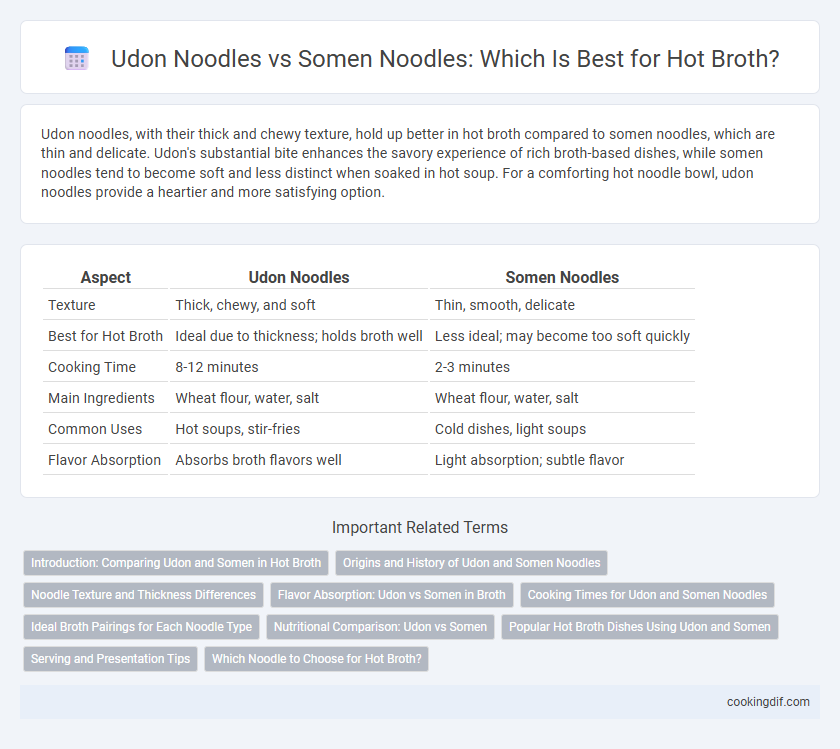Udon noodles, with their thick and chewy texture, hold up better in hot broth compared to somen noodles, which are thin and delicate. Udon's substantial bite enhances the savory experience of rich broth-based dishes, while somen noodles tend to become soft and less distinct when soaked in hot soup. For a comforting hot noodle bowl, udon noodles provide a heartier and more satisfying option.
Table of Comparison
| Aspect | Udon Noodles | Somen Noodles |
|---|---|---|
| Texture | Thick, chewy, and soft | Thin, smooth, delicate |
| Best for Hot Broth | Ideal due to thickness; holds broth well | Less ideal; may become too soft quickly |
| Cooking Time | 8-12 minutes | 2-3 minutes |
| Main Ingredients | Wheat flour, water, salt | Wheat flour, water, salt |
| Common Uses | Hot soups, stir-fries | Cold dishes, light soups |
| Flavor Absorption | Absorbs broth flavors well | Light absorption; subtle flavor |
Introduction: Comparing Udon and Somen in Hot Broth
Udon noodles offer a thick, chewy texture that holds up well in hot broth, creating a hearty and satisfying meal. Somen noodles, thinner and more delicate, cook quickly and absorb flavors efficiently, making them ideal for lighter broths. The choice between udon and somen in hot soups depends on the desired texture and broth intensity, with udon providing substance and somen emphasizing subtlety.
Origins and History of Udon and Somen Noodles
Udon noodles originated in Japan during the Nara period, around the 8th century, and developed as a thick wheat-based noodle suited to rich, hot broths. Somen noodles, thinner and made from wheat flour, date back to the Heian period and were initially enjoyed chilled but later adapted for light hot soups. The distinct textures and historical culinary uses of udon and somen reflect their regional and seasonal significance in Japanese cuisine.
Noodle Texture and Thickness Differences
Udon noodles have a thicker, chewier texture ideal for hot broth, providing a hearty and satisfying mouthfeel that holds up well in soups. Somen noodles are much thinner with a delicate, smooth texture, which softens quickly and offers a lighter experience in hot broth. The thickness difference--udon being significantly thicker than somen--affects their ability to absorb flavors and maintain texture in warm liquids.
Flavor Absorption: Udon vs Somen in Broth
Udon noodles, with their thick and chewy texture, excel at absorbing rich, savory hot broth flavors, making each bite deeply satisfying and flavorful. Somen noodles, being thin and delicate, absorb broth more subtly, allowing for a lighter flavor experience that highlights the broth's nuances without overpowering them. The choice between udon and somen for hot broth depends on whether a robust or gentle flavor absorption is desired.
Cooking Times for Udon and Somen Noodles
Udon noodles require a longer cooking time, typically 8 to 12 minutes, to achieve their thick, chewy texture, making them ideal for hot broth as they hold up well without becoming mushy. Somen noodles cook much faster, usually within 2 to 3 minutes, offering a delicate and light texture that can quickly soften in hot broth, which may make them less suitable for longer simmering. Choosing between udon and somen noodles for hot broth largely depends on desired texture and cooking time, with udon providing durability and somen offering a tender, quick-cook option.
Ideal Broth Pairings for Each Noodle Type
Udon noodles, thick and chewy, hold up well in rich, savory broths like kakejiru made from dashi, soy sauce, and mirin, delivering a hearty and warming dish. Somen noodles, thin and delicate, are best paired with lighter broths such as chilled tsuyu or mild chicken broth, preserving their subtle texture and flavor. Choosing the right broth enhances the unique characteristics of udon and somen, ensuring an optimal balance of taste and mouthfeel.
Nutritional Comparison: Udon vs Somen
Udon noodles contain more calories and carbohydrates per serving compared to somen noodles, providing greater energy density which is ideal for hot broth meals requiring sustained warmth. Somen noodles are lower in calories and contain slightly less protein, making them a lighter option better suited for delicate broth flavors. Both noodles offer minimal fat content, but udon's higher gluten content enhances its chewy texture, while somen's thin strands cook faster and absorb broth flavors more subtly.
Popular Hot Broth Dishes Using Udon and Somen
Udon noodles, thick and chewy, are ideal for hot broth dishes like Kake Udon and Nabeyaki Udon, where their texture holds up well in rich, savory soups. Somen noodles, thinner and more delicate, are commonly used in lighter hot broth dishes such as Nyumen, providing a subtle contrast without overpowering the clear dashi-based broth. Both noodles enhance the flavor profile of hot soups but are chosen based on desired texture and broth intensity.
Serving and Presentation Tips
Udon noodles, with their thick and chewy texture, hold up well in hot broth, offering a satisfying bite and a comforting, hearty feel ideal for rustic bowls garnished with scallions, tempura flakes, and a soft-boiled egg. Somen noodles, thinner and more delicate, are better suited for light broths or chilled presentations, often served neatly twirled or in bundles to highlight their elegant appearance and smooth texture. When serving udon, place toppings visibly atop the noodles to enhance visual appeal, while somen benefits from minimalist plating that emphasizes its fine strands and subtle flavor.
Which Noodle to Choose for Hot Broth?
Udon noodles, with their thick, chewy texture, hold up well in hot broth, providing a satisfying bite and absorbing flavors more effectively than thin somen noodles. Somen noodles, being thinner and more delicate, cook quickly and are best suited for light broths or cold dishes to prevent becoming overly soft. For rich, hearty hot broths, udon is the preferred choice due to its robustness and ability to complement intense flavors.
Udon noodles vs somen noodles for hot broth Infographic

 cookingdif.com
cookingdif.com